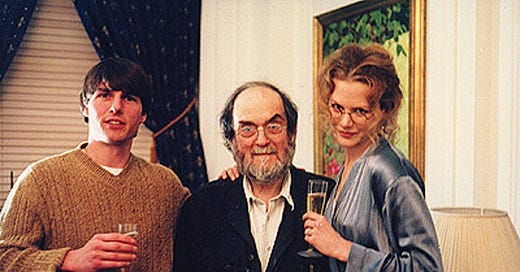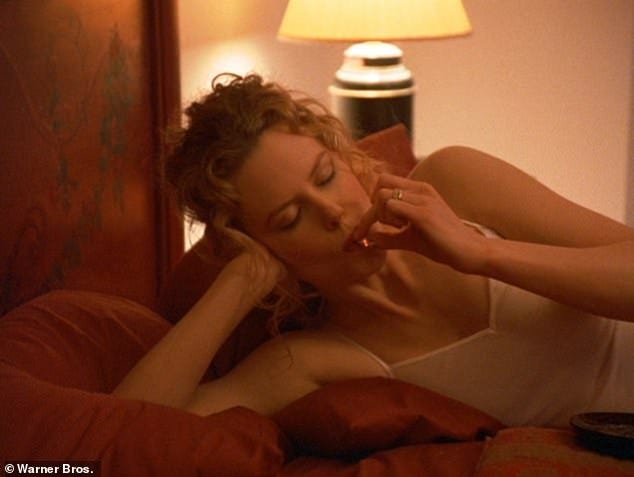I remember coming off the plane, March 7, 1999. I was flying from Los Angeles to Las Vegas for ShoWest (now CinemaCon) and I landed at McCarron (now Harry Reid) and there were messages on my phone. Could I call back to comment about the death of Stanley Kubrick.
Fuck!
For me, Kubrick was The One. So many fantastic filmmakers… but for me, Kubrick. I never got to meet him. He was an even more mysterious figure back then. More stuff has come out about him since his passing. People who would not speak about the man and his work started speaking about the man and his work.
And then there was this movie.
People hated Eyes Wide Shut. I could understand why. They had been sold a movie that seemed to be about the world’s most watched couple having sex on camera. But it wasn’t a movie about that at all.
I didn’t hate the film. But I wasn’t really sure what it was. The movie opened in July. I saw it a 2 or 3 times on screen. But I was still trying to put the pieces together. Then the Oscar season disc arrived and I watched it another dozen times… it was making more sense. Eventually, there was the Frederic Raphael book about co-writing the film… and the original basis for the idea, Arthur Schnitzler’s 1926 novella, Traumnovelle, which I read in translated English. (I was committed, but not enough to learn German.) And critically, the European cut of the film, without the digital bodies blocking the orgy sequence… which blocked the ability to see the falseness of that orgy.
I wrote a lot about the film, including what I considered a pretty complex and definitive analysis at roughcut.com. But it disappeared when AOL shut down the site. I’ve had a lot of requests to find or recreate that analysis over the years, but I just couldn’t bring myself to do it, until now.
I am not going to dig as deep as I did the first time around. Not doing deep color analysis. If you respond to the phrase “the 4 different colored paintings in the hallway of the hospital,” you may have gone down that well yourself. There is, it turns out, a Twitter feed, dedicated to an absolute obsession with the film and anything related to it. I salute them… and decline to compete at that level.
So here we go…
Understanding Eyes Wide Shut requires a willingness to accept the feel of a dream state. Not everything fits on a literal basis, even in the world of dreams. Kubrick made a movie about 2 dreams that are kind of waking dreams… and kind of not.
Right at the end of the film, Nicole Kidman’s Alice Harford says to Tom Cruise’s Bill Harford, “The reality of one night, let alone that of a whole lifetime, can never be the whole truth.” He responds, “And no dream is ever just a dream.”
The film is much, much simpler than I think people - even some who love it - want it to be. The film is about a couple in a lull moment in their marriage. Her focus is on their child. His focus is on his work. They are as beautiful as the day they married. But they are not connecting the same way anymore.
The movie starts with them preparing for and then going to a lavish Christmas party. He is the host’s doctor… but though they are a successful couple living in a huge apartment in Manhattan, they are not wealthy the way his patients are wealthy. Both he and she are latched onto by hungry sexual prospects at the party, after she breaks off from him, pretending to head to the bathroom, when she actually heads right for some more champagne in another room.
Dr. Bill, always maintaining his most professional fake self, is called away from the 2 women who want to take him to some quiet room so that he might help the host, who is half-naked in his huge private bathroom with a naked girl when Dr. Bill arrives.
The girl, Mandy, has “shot up” the wrong drug or group of drugs and is in physical distress. Dr. Bill manages the situation. Mandy, in what will not turn out to be a coincidence, has red hair and blue eyes. Also not a coincidence, this will be one of the few times in the film where a window doesn’t have red curtains and where the window is stained glass, not allowing light - blue light - in. (More on that later)
Meanwhile, a tall, handsome foreign man tries to seduce Alice, the conversation floating in and out of questions about the boundaries of marriage. She pushes herself away.
Next scene, the Harfords are back at home. And she is naked in front of a mirror. Bill sidles up to her, but both seem more interested in looking at themselves in the mirror than having sex… which they may or may not have… probably not.
The next day, their lives go on. Dr. Bill pointedly has one patient with red hair who is topless with beautiful breasts of a size and shape that are not dissimilar to Mandy’s and the size and shape of which we will see quite a lot in the film.
That night, Alice breaks out a joint and the couple discuss the party a little, which leads to Bill telling Alice that he understands why a man would dance with her and want to have sex with her. She angrily translates this into the idea that the only reason a man would talk to her was because she was beautiful and sexually attractive... and that he didn’t have sex with the women hitting on him at the party “out of consideration for her.” She then responds to by telling him a story about how she fantasized about a man at a hotel they were once at and how she would have given up everything - specifically mentioning their marriage and their child - for just one night with him.
The low-temperature fight ends, unresolved, with a phone call that a patient has died and Bill needs to visit the family.
This happens at about 37 minutes into the 2 hour and 39 minute film. Why does this matter? Because the end of this sequence also marks the start of what will be the meat on the movie… 2 dreams of Dr. Bill Harford that end almost exactly at the 2-hour mark of the film, allowing the almost 37-minute post-dream part of the film to happen in what is a very symmetrical form.
THE DREAMS
There are 6 well-defined elements to each of the 2 dreams Dr. Bill has in the film, each of which becomes the opposite of the previous version of the same thing in the next dream. In other words, if it happens in the first dream, the opposite happens in the next.
Keep reading with a 7-day free trial
Subscribe to The Hot Button by David Poland to keep reading this post and get 7 days of free access to the full post archives.





